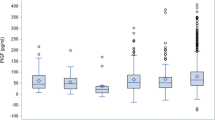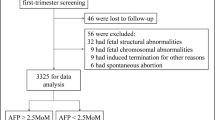Abstract
Objective
This study was designed to investigate the relationship between the second trimester maternal serum markers and adverse pregnancy outcomes in healthy newborns.
Materials and methods
A total of 749 women who delivered in our institution with complete follow up and second-trimester triple marker test data available were included in the study. Women with multiple pregnancies, chronic diseases, diabetes mellitus, obesity, smokers and infants with chromosomal and congenital abnormalities were excluded. Maternal serum alpha-fetoprotein (AFP), human chorionic gonadotropin (HCG) and unconjugated estriol (uE3) values were investigated in our cohort who developed preeclampsia (n = 28), gestational diabetes (GM) (n = 69), preterm labor-birth (n = 100), oligohydramnios (n = 37) and macrosomia (n = 59) by using receiver operating characteristic (ROC) curve analysis, with chi-square and Pearson’s correlation tests.
Results
Women with uE3 ≤ 1.26 MoM (P = 0.001, AUC = 0.666), HCG > 1.04 MoM (P = 0.032, AUC = 0.599) or AFP ≤ 0.69 MoM (P = 0.049, AUC = 0.600) values significantly developed oligohydramnios. Also, macrosomic infants were observed in women who had HCG values > 0.86 MoM (P = 0.047, AUC = 0.578). Patients with HCG > 1.04 MoM (P = 0.04, AUC = 0.565) and uE3 ≤0.88 MoM (P = 0.049, AUC = 0.571) developed GDM. HCG levels ≥2.5 or ≥3 MoM were significantly associated with the development of oligohydramnios [P = 0.005; OR = 4 (95% CI: 1.7–9.7)], [P = 0.008; OR = 4.9 (95% CI: 1.7–13.7)], respectively. When women with adverse (n = 237) and normal (n = 512) outcomes were compared there were significant differences in maternal serum AFP (1.40 ± 0.84 vs. 1.23 ± 0.75 MoM, P = 0.006) and uE3 values (1.38 ± 1.42 vs. 1.45 ± 0.98 MoM, P = 0.001).
Conclusions
Serum estriol, AFP or HCG values in triple test results may be associated with development of oligohydramnios, gestational diabetes and macrosomia in women with healthy and normal appearing fetuses.



Similar content being viewed by others
References
Cunningham FG, Leveno KJ, Bloom SL, Hauth JC, Gilstrap III LC, Wenstrom KD (2005) Williams obstetrics. 22nd edn. McGraw-Hill, New York pp 313–340
Yaron Y, Cherry M, Kramer RL, O’Brien JE, Hallak M, Johnson MP et al (1999) Second-trimester maternal serum marker screening: maternal serum α-fetoprotein, β-human chorionic gonadotropin, estriol, and their various combinations as predictors of pregnancy outcome. Am J Obstet Gynecol 181:968–974
Onderoglu LS, Kabukçu A (1997) Elevated second trimester human chorionic gonadotropin level associated with adverse pregnancy outcome. Int J Gynecol Obstet 56:245–249
Walter DK, Lustig LS, Cunningham GC, Feuchtbaum LB, Hook EB (1996) The association between maternal serum alpha-fetoprotein and preterm birth, small for gestational age infants, preeclampsia, and placental complications. Obstet Gynecol 88:816–822
Stamilio DM, Sehdev HM, Morgan MA, Propert K, Macones GA (2000) Can antenatal clinical and biochemical markers predict the development of severe preeclampsia? Am J Obstet Gynecol 182:589–594
Walton DL, Norem CT, Schoen EJ, Ray T, Colby CJ (1999) Second-trimester serum chorionic gonadotropin concentrations and complications and outcome of pregnancy. N Engl J Med 341:2033–2036
Spencer K (2000) Second-trimester prenatal screening for Down syndrome and the relationship of maternal serum biochemical markers to pregnancy complications with adverse pregnancy outcome. Prenat Diagn 20:652–656
American Diabetes Association (2003) Position statement: gestational diabetes mellitus. Diabetes Care 26(Suppl. 1):S103–S105
Zweig MH, Campbell G (1993) Receiver-operating characteristic (ROC) plots: a fundamental evaluation tool in clinical medicine. Clin Chem 39:561–577
Wenstrom KD, Owen J, Boots LR, Dubard MB (1994) Elevated second-trimester human chorionic gonadotropin levels in association with poor pregnancy outcome. Am J Obstet Gynecol 171:1038–1041
Bernstein IM, Bart RA, Miller R, Capeless EL (1992) Elevated maternal serum alpha-fetoprotein: association with placental sonolucencies, fetomaternal hemorrhage, vaginal bleeding and pregnancy outcome in the absence of fetal anomalies. Obstet Gynecol 79:71–74
Huerta-Enochian G, Katz W, Erfurth S (2001) The association of abnormal α-fetoprotein and adverse pregnancy outcome: does increased fetal surveillance affect pregnancy outcome? Am J Obstet Gynecol 184:1549–1553
Duric K, Skrablin S, Lesin J, Kalafatic D, Kuvacic I, Suchanek E (2003) Second trimester total human chorionic gonadotropin, alpha-fetoprotein and unconjugated estriol in predicting pregnancy complications other than fetal aneuploidy. Eur J Obstet Gynecol Reprod Biol 110:12–15
Boyd PA (1992) Why might maternal serum AFP be high in pregnancies in which the fetus is normally formed? Br J Obstet Gynaecol 99:93–95
Kıran TSU, Bethel J, Bhal PS (2005) Correlation of abnormal second trimester maternal serum alpha-fetoprotein (MSAFP) levels and adverse pregnancy outcome. J Obstet Gynaecol 25:253–256
Berkeley AS, Killackey MA, Cederqvist LL (1983) Elevated maternal serum α-fetoprotein levels associated with breakdown in fetal-maternal-placental barrier. Am J Obstet Gynecol 146:859–861
Boyd PA, Keeling JW (1986) Raised maternal serum α-fetoprotein in the absence of fetal abnormality-placental founding: a quantitative morphometric study. Prenat Diagn 6:369–373
Luckas MJM, Sandland R, Hawe J, Neilson JP, McFadyen IR, Meekins JW (1998) Fetal growth retardation and second trimester maternal serum human chorionic gonadotropin levels. Placenta 19:143–147
Lepage N, Chitayat D, Kingdom J, Huang T (2003) Association between second-trimester isolated high maternal serum human chorionic gonadotropin levels and obstetric complications in singleton and twin pregnancies. Am J Obstet Gynecol 188:1354–1359
Ashour AM, Lieberman ES, Wilkins Haug LE, Repke JT (1997) The value of elevated second-trimester β-human chorionic gonadotropin in predicting development of preeclampsia. Am J Obstet Gynecol 176:438–442
Summers A, Huang T, Meier C, Wyatt PR (2003) The implications of a false positive second-trimester serum screen for Down syndrome. Obstet Gynecol 101:1301–1306
Towner D, Gandhi S, El Kady D (2006) Obstetrics outcomes in women with elevated maternal serum human chorionic gonadotropin. Am J Obstet Gynecol 194:1676–1682
Gonen R, Perez R, David M, Dar H, Merksamer R, Sharf M (1992) The association between unexplained second-trimester maternal serum hCG elevation and pregnancy complications. Obstet Gynecol 80:83–86
Liu DF, Dickerman LH, Redline RW (1999) Pathological findings in pregnancies with unexplained increases in midtrimester maternal serum human chorionic gonadotropin levels. Am J Clin Pathol 111:209–215
Sayin NC, Varol FG, Duran R, Acunas B, Kurt I (2007) Perinatal outcome in women screened for gestational diabetes mellitus with normal or with one elevated glucose tolerance test value. J Turkish German Gynecol Assoc 8:38–43
Kowalczyk TD, Cabaniss ML, Cusmano L (1998) Association of low unconjugated estriol in the second trimester and adverse pregnancy outcome. Obstet Gynecol 91:396–400
Kim SY, Kim SK, Lee JS, Kim IK, Lee K (2000) The prediction of adverse pregnancy outcome using low unconjugated estriol in the second trimester of pregnancy without risk of Down’s syndrome. Yonsei Med J 41:226–229
Isouard G (1979) Measurement of serum levels of oestriol and human placental lactogen in the management of preeclamptic pregnancies. Med J Aust 2:401–404
Goodwin TM (1999) A role for estriol in human labor, term and preterm. Am J Obstet Gynecol 180:208–213
Dugoff L, Hobbins JC, Malone FD, Vidaver J, Sullivan L, Canick JA et al, for the FASTER Trial Research Consortium (2005) Quad screen as a predictor of adverse pregnancy outcome. Obstet Gynecol 106:260–267
Pergament E, Stein AK, Fiddler M, Cho NH, Kupferminc MJ (1995) Adverse pregnancy outcome after a false-positive screen for Down syndrome using multiple markers. Obstet Gynecol 86:255–258
Salafia CM, Silberman C, Herrerra NE, Mahoney MJ (1988) Placental pathology at term associated with elevated midtrimester maternal serum AFP concentration. Am J Obstet Gynecol 158:1064–1066
Acknowledgment
Conflict of interest: The authors have no connection to any of the companies or products mentioned in this article. We (the authors) state that we had full control of all primary data and we agree to allow the Journal to review our data if requested.
Author information
Authors and Affiliations
Corresponding author
Additional information
Presented in part at the VI. Congress of the Turkish-German Gynecological Association, Antalya, May 18–22, 2005. Abstract, S12, Arch Gynecol Obstet 2005; 271 (Suppl 1-Abstract Book): Poster-MFM&P-32.
Rights and permissions
About this article
Cite this article
Sayın, N.C., Canda, M.T., Ahmet, N. et al. The association of triple-marker test results with adverse pregnancy outcomes in low-risk pregnancies with healthy newborns. Arch Gynecol Obstet 277, 47–53 (2008). https://doi.org/10.1007/s00404-007-0421-6
Received:
Accepted:
Published:
Issue Date:
DOI: https://doi.org/10.1007/s00404-007-0421-6




